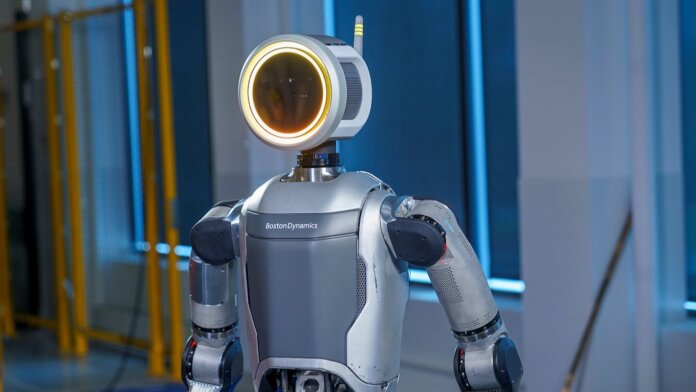Yesterday, Boston Dynamics announced it was retiring its hydraulic Atlas robot. Atlas has long been the standard bearer of advanced humanoid robots. Over the years, the company was known as much for its research robots as it was for slick viral videos of them working out in military fatigues, forming dance mobs, and doing parkour. Fittingly, the company put together a send-off video of Atlas’s greatest hits and blunders.
But there were clues this wasn’t really the end, not least of which was the specific inclusion of the word “hydraulic” and the last line of the video, “‘Til we meet again, Atlas.” It wasn’t a long hiatus. Today, the company released hydraulic Atlas’s successor—electric Atlas.
The new Atlas is notable for several reasons. First, and most obviously, Boston Dynamics has finally done away with hydraulic actuators in favor of electric motors. To be clear, Atlas has long had an onboard battery pack—but now it’s fully electric. The advantages of going electric include less cost, noise, weight, and complexity. It also allows for a more polished design. From the company’s own Spot robot to a host of other humanoid robots, fully electric models are the norm these days. So, it’s about time Atlas made the switch.
Without a mess of hydraulic hoses to contend with, the new Atlas can now also contort itself in new ways. As you’ll note in the release video, the robot rises to its feet—a crucial skill for a walking robot—in a very, let’s say, special way. It folds its legs up along its torso and impossibly, for a human at least, pivots up through its waist (no hands). Once standing Atlas swivels its head 180 degrees, then does the same thing at each hip joint and the waist. It takes a few watches to really appreciate all the weirdness there.
The takeaway is that while Atlas looks like us, it’s capable of movements we aren’t and therefore has more flexibility in how it completes future tasks.
This theme of same-but-different is evident in its head too. Instead of opting for a human-like head that risks slipping into the uncanny valley, the team chose a featureless (for now) lighted circle. In an interview with IEEE Spectrum, Boston Dynamics CEO, Robert Playter, said the human-like designs they tried seemed “a little bit threatening or dystopian.”
“We’re trying to project something else: a friendly place to look to gain some understanding about the intent of the robot,” he said. “The design borrows from some friendly shapes that we’d seen in the past. For example, there’s the old Pixar lamp that everybody fell in love with decades ago, and that informed some of the design for us.”
While most of these upgrades are improvements, there is one area where it’s not totally clear how well the new form will fair: strength and power.
Hydraulics are known to provide both, and Atlas pushed its hydraulics to their limits carrying heavy objects, executing backflips, and doing 180-degree, in-air twists. According to the press release and Playter’s interviews, little has been lost in this category. In fact, they say, electric Atlas is stronger than hydraulic Atlas. Still, as with all things robotics, the ultimate proof of how capable it is will likely be in video form, which we’ll eagerly await.
Despite big design updates, the company’s messaging is perhaps more notable. Atlas used to be a research robot. Now, the company intends to sell them commercially.
This isn’t terribly surprising. There are now a number of companies competing in the humanoid robots space, including Agility, 1X, Tesla, Apptronik, and Figure—which just raised $675 million at a $2.6 billion valuation. Several are making rapid progress, with a heavy focus on AI, and have kicked off real-world pilots.
Where does Boston Dynamics fit in? With Atlas, the company has been the clear leader for years. So, it’s not starting from the ground floor. Also, thanks to its Spot and Stretch robots, the company already has experience commercializing and selling advanced robots, from identifying product-market fit to dealing with logistics and servicing. But AI was, until recently, less of a focus. Now, they’re folding reinforcement learning into Spot, have begun experimenting with generative AI too, and promise more is coming.
Hyundai acquired Boston Dynamics for $1.1 billion in 2021. This may prove advantageous, as they have access to a world-class manufacturing company along with its resources and expertise producing and selling machines at scale. It’s also an opportunity to pilot Atlas in real-world situations and perfect it for future customers. Plans are already in motion to put Atlas to work at Hyundai next year.
Still, it’s worth noting that, although humanoid robots are attracting attention, getting big time investment, and being tried out in commercial contexts, there’s likely a ways to go before they reach the kind of generality some companies are touting. Playter says Boston Dynamics is going for multi-purpose, but still niche, robots in the near term.
“It definitely needs to be a multi-use case robot. I believe that because I don’t think there’s very many examples where a single repetitive task is going to warrant these complex robots,” he said. “I also think, though, that the practical matter is that you’re going to have to focus on a class of use cases, and really making them useful for the end customer.”
Humanoid robots that tidy your house and do the dishes may not be imminent, but the field is hot, and AI is bringing a degree of generality not possible a year ago. Now that Boston Dynamics has thrown its name in the hat, things will only get more interesting from here. We’ll be keeping a close eye on YouTube to see what new tricks Atlas has up its sleeve.
Image Credit: Boston Dynamics



